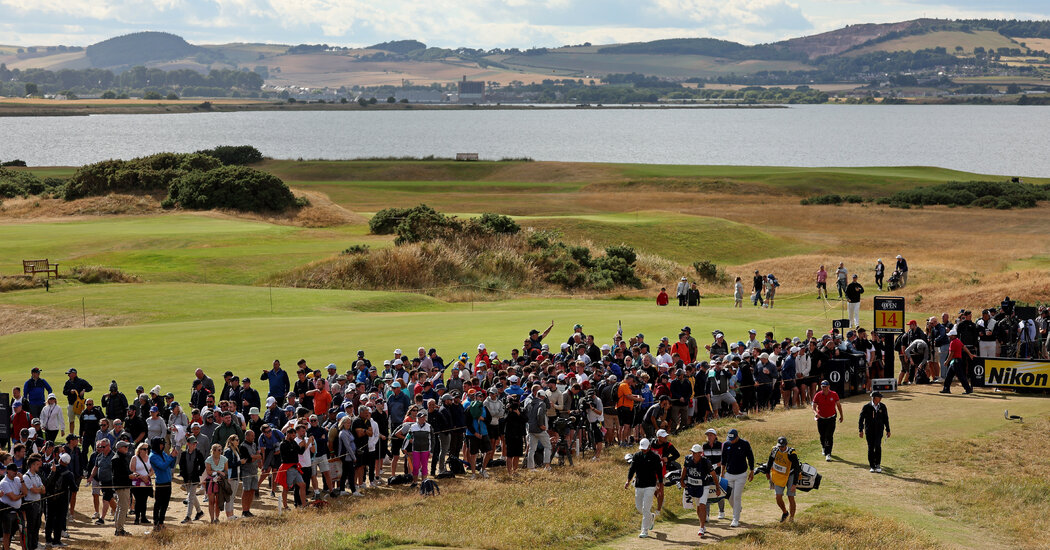
ST. ANDREWS, Scotland — It is the rare golfer who does not fret over weather that could wash out a round or starve shots of distance.
But along the North Sea on a blustery edge of Scotland, heralded for centuries as golf’s birthplace, this era’s greenskeepers fear a far more damning forecast. In that nightmare, what they call a perfect storm, striking at high tide and packing an easterly wind, would hit, likely speeding coastal erosion.
“Year on year, we’re just apprehensive,” said David Brown, the general manager at the 460-year-old Montrose Golf Links.
“You’re kind of fighting the unknown, really,” he said. “We could go for the next 10 years not having that perfect storm, and then quite easily in one winter, we could have that perfect storm three times. And then how much land do we lose?”
Montrose, which the government estimates has lost dozens of yards of coastline over the last several decades, is thought to be among the most imperiled of Scotland’s roughly 600 courses, more than one in six of which are coastal. In a sign, though, of how global prestige can offer only so much in the way of safety, researchers believe that St. Andrews, home to the world’s oldest course and the host of the 150th British Open, faces a greater threat of flooding within 30 years.
Scientists do not think that the Old Course will be permanently underwater that soon, with the Road Hole forever swallowed into the sea. But golf has had little choice but to start weighing its own role in climate change — most notably through the vast, lush and thirsty courses that sometimes take the place of trees and then require fertilizer and mowing — while puzzling over how to preserve fairways and greens around the world.
Scientists have spent years warning how a warmer planet, which can lead to more severe storms and to more sea-level rise, could change sports. Citing climate change, the International Olympic Committee’s president has said that Games organizers “may have to have a look into the overall calendar and whether there must be a shift.” Winter sports are facing a future of events on artificial snow, and activities like dogsledding and fishing are being transformed in the Arctic.
Golf will not be an exception.
“Some of our most historic, famous and revered golf courses are at risk, and it is something every coastal course needs to think hard about,” said Tim Lobb, the president of the European Institute of Golf Course Architects, who predicted an acceleration of the kind of turf-reduction efforts that have already started at some courses.
Scotland’s long embrace of golf as a cultural and economic juggernaut lends the issue particular urgency in this region, where the Open is scheduled to conclude on Sunday. At St. Andrews Links alone, six public courses, including the Old Course, together host some 230,000 rounds a year close to the West Sands, a quick stroll from some of the most revered holes in the world. (A seventh St. Andrews Links course, which opened in 2008, is elsewhere in the area.)
Courses in Scotland’s east, which has low-lying sediment that can be easily eroded, are generally believed to face more imminent jeopardy than ones along the west coast, where the geology is less vulnerable to climate change’s consequences.
But responses are becoming widespread.
Royal Dornoch, a beloved course in the north of Scotland, has been trying to revive marsh that had eroded and threatened a fairway. Lundin, about a half-hour’s drive from St. Andrews, added 100,000 pounds in fencing to guard against erosion, and the R&A, the Open’s organizer, has earmarked hundreds of thousands of pounds for grants to “develop solutions.”
There may be limits to what courses can do, though, their options sometimes narrowed by money, location, the severity of the threat or the rippling consequences of action in one area. Some people worry that resources that might be made available to a place like the Old Course, which is rich with history and international import, might be not be as accessible elsewhere.
“There are fears about golf courses, but we will help to protect golf courses if we do the right things to protect the environment and mitigate and adapt to the effects of climate change,” Nicola Sturgeon, Scotland’s first minister, said in a seaside interview on Friday. “There’s a huge amount of work that we’re doing in Scotland to do that. It’s about more than protecting golf courses, but there is no doubt in places like this that that is a key part of it as well.”
She added: “The climate is changing, but we are really focusing in Scotland on making sure that we protect what matters most to us as we face these challenges. And it’s very obvious during this week of the year, in particular, how much golf matters to Scotland.”
Some experts, including Professor Bill Austin of the University of St. Andrews, expect a rising number of engineering fixes to take hold over the years, balanced with more natural solutions that might involve allowing the sea to creep inward in a managed way.
One of the persistent questions, though, is whether those efforts will materialize fast enough.
At Montrose, Brown runs a course that has lately been in the stopgap business, voluntarily and not: Tees have been lost, holes have been shortened and redirected and fairways have been overseeded. There is only so much money to go around, though, and climate-related modifications are consuming roughly a third of the course’s greens budget.
“Without government protection, we could see 50 years of golf played comfortably — or the perfect storm two or three times in one winter, 10 years,” he said.
The worries around St. Andrews are not yet as dire, but they are mounting. In an especially grim possibility outlined last year in a report from a Scottish government project, part of the West Sands could draw about 750 meters into the links by 2100 if there are high emissions and a “do nothing” approach to managing the coast.
And Climate Central, a research group based in Princeton, N.J., has forecast that the Old Course and the surrounding area will become more susceptible to temporary, if drenching, floodwaters by 2050.
Austin, based in the School of Geography and Sustainable Development at St. Andrews, also expects flooding to threaten the Old Course and said that breaches “may be inevitable.” Further enhancements to the dunes, especially around the estuary end, might offer greater protection for the course, he said, building on years of work that St. Andrews Links has already done.
The government report also suggested beach nourishment efforts and the possibility of redesigning courses “to ensure golf can sustainably be played at St. Andrews beyond 2100.”
How long, exactly, is unclear.
“I’m sure there will be a 200th Open played on something that looks very similar to the present-day Old Course, but there may be some engineering behind the scenes,” Austin, who has received some research funding from the R&A, said at a coffeehouse in St. Andrews on a rainy morning this past week.
Beyond that, though, his prognostication is more foreboding.
“If you asked me about 300, then I’d say the Old Course will have moved,” he said, “but there will still be something in St. Andrews that has the feel and, I think, the legacy of the Old Course.”




